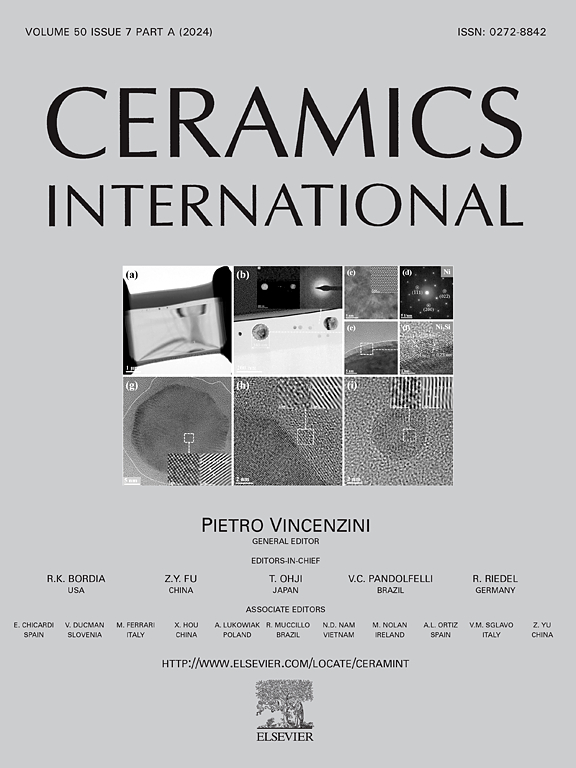Phyto-mediated synthesis of CeO2/ZrO2 nanocomposite: A potential performer for multifarious biomedical applications
IF 5.6
2区 材料科学
Q1 MATERIALS SCIENCE, CERAMICS
引用次数: 0
Abstract
This study reports the synthesis of CeO2/ZrO2 nanocomposite via the biogenic route utilizing Citrus limonium (lemon juice) along with the CeO2 and ZrO2 nanoparticles for comparative purposes. The XRD analysis confirms the effectual formation of phase-pure and good crystalline CeO2/ZrO2 nanocomposite, exhibiting a mixed cubic and tetragonal structure with an average crystallite size of 66 nm. FT-IR analysis exposes the characteristic metal-oxygen bonds along with organic functional moieties. The UV-visible diffuse reflectance results show strong absorption from 200 to 420 nm for the CeO2/ZrO2 nanocomposite, with a bandgap of 3.22 eV. The surface morphology of the nanocomposite reveals a foundation of irregular, block-like ZrO2 structures, with affixed smaller aggregates of CeO2 on the ZrO2 surface with interstices between them. Furthermore, the co-occurrence of Ce3+ and Ce4+ oxidation states, along with Zr4+ and surface oxygen species, significantly boosts the nanocomposite's redox activity. Antibacterial assays demonstrated that the CeO2/ZrO2 nanocomposite exhibited the highest inhibition zones in Salmonella typhi and Bacillus subtilis, surpassing individual nanoparticles. Antioxidant studies show 83% DPPH radical scavenging activity and 88% superoxide anion free radical scavenging activity. The antidiabetic activity study shows 89% inhibition of α-amylase and 86% inhibition of α-glucosidase at 950 μg/mL, which is better than the individual nanoparticles. This insightful study emphasizes the compelling potential of CeO2/ZrO2 nanocomposite for advancing therapeutic strategies and significantly improving clinical outcomes across a range of medical conditions.
植物介导的CeO2/ZrO2纳米复合材料的合成:多种生物医学应用的潜在表演者
本研究报道了利用柠檬汁和CeO2和ZrO2纳米粒子进行比较,通过生物源途径合成CeO2/ZrO2纳米复合材料。XRD分析证实了CeO2/ZrO2纳米复合材料的有效形成,其结构为立方和四方混合结构,平均晶粒尺寸为66 nm。FT-IR分析揭示了特征金属-氧键以及有机功能基团。结果表明,CeO2/ZrO2纳米复合材料在200 ~ 420 nm范围内具有较强的吸收,带隙为3.22 eV。纳米复合材料的表面形貌显示出不规则的块状ZrO2结构的基础,ZrO2表面附着着较小的CeO2聚集体,它们之间有间隙。此外,Ce3+和Ce4+氧化态的共存,以及Zr4+和表面氧的共同存在,显著提高了纳米复合材料的氧化还原活性。抑菌实验表明,CeO2/ZrO2纳米复合材料对伤寒沙门氏菌和枯草芽孢杆菌的抑菌效果优于单个纳米颗粒。抗氧化研究表明,其对DPPH自由基的清除能力为83%,对超氧阴离子自由基的清除能力为88%。抗糖尿病活性研究表明,在950 μg/mL浓度下,对α-淀粉酶的抑制率为89%,对α-葡萄糖苷酶的抑制率为86%,优于单个纳米颗粒。这项富有洞察力的研究强调了CeO2/ZrO2纳米复合材料在推进治疗策略和显著改善一系列医疗条件下的临床结果方面的巨大潜力。
本文章由计算机程序翻译,如有差异,请以英文原文为准。
求助全文
约1分钟内获得全文
求助全文
来源期刊

Ceramics International
工程技术-材料科学:硅酸盐
CiteScore
9.40
自引率
15.40%
发文量
4558
审稿时长
25 days
期刊介绍:
Ceramics International covers the science of advanced ceramic materials. The journal encourages contributions that demonstrate how an understanding of the basic chemical and physical phenomena may direct materials design and stimulate ideas for new or improved processing techniques, in order to obtain materials with desired structural features and properties.
Ceramics International covers oxide and non-oxide ceramics, functional glasses, glass ceramics, amorphous inorganic non-metallic materials (and their combinations with metal and organic materials), in the form of particulates, dense or porous bodies, thin/thick films and laminated, graded and composite structures. Process related topics such as ceramic-ceramic joints or joining ceramics with dissimilar materials, as well as surface finishing and conditioning are also covered. Besides traditional processing techniques, manufacturing routes of interest include innovative procedures benefiting from externally applied stresses, electromagnetic fields and energetic beams, as well as top-down and self-assembly nanotechnology approaches. In addition, the journal welcomes submissions on bio-inspired and bio-enabled materials designs, experimentally validated multi scale modelling and simulation for materials design, and the use of the most advanced chemical and physical characterization techniques of structure, properties and behaviour.
Technologically relevant low-dimensional systems are a particular focus of Ceramics International. These include 0, 1 and 2-D nanomaterials (also covering CNTs, graphene and related materials, and diamond-like carbons), their nanocomposites, as well as nano-hybrids and hierarchical multifunctional nanostructures that might integrate molecular, biological and electronic components.
 求助内容:
求助内容: 应助结果提醒方式:
应助结果提醒方式:


